16 Incredible Tulip Divisions With Pictured Varieties And Different Seasons Of Interest

Reviewed By ROY NICOL

Roy is a Professional Gardener and Horticultural Consultant, specialising in large garden year-round maintenance and garden development. He is an RHS Master of Horticulture and uses his research in the application of no-dig methods in ornamental garden settings. Roy has been a Professional Gardener for more than six years and is a member of the Chartered Institute of Horticulture, Professional Gardener's Guild and Association of Professional Landscapers (Professional Gardener).
IN THIS GUIDE
- Division 1: Single Early
- Division 2: Double Early
- Division 3: Triumph
- Division 4: Darwin Hybrid
- Division 5: Single Late
- Division 6: Lily-Flowered
- Division 7: Fringed
- Division 8: Virdiflora
- Division 9: Rembrandt
- Division 10: Parrot
- Division 11: Double Late
- Division 12: Kaufmanniana
- Division 13: Fosteriana
- Division 14: Greigii
- Division 15: Species
- Division 16: Multiflowering
- References
TULIP GUIDES
Container Growing
Deadheading
Varieties
Botanically, Genus Tulipa is a member of Family Liliaceae – it includes around 100 (natural) species.1Tulipa. (n.d.). Pacific Bulb Society. Retrieved March 27, 2023, from https://www.pacificbulbsociety.org/pbswiki/index.php/Tulipa
The genus’s native range stretches from Eastern Europe, through Asia to China.2Tulip Species. (n.d.). Chicago Botanic Garden. Retrieved December 4, 2023, from https://www.chicagobotanic.org/plantinfo/tulips_species
A large number of tulip varieties, as bulbs, put up one stem with one flower.
One stem and one flower it may be but the number of Tulip varieties is nearly 4,000 and counting as floriculturists are driven to develop new varieties, bred for cut-flower life, disease resistance, newer colours, and more striking forms.3The Editors of Encyclopaedia Britannica. (1999c, May 4). Tulip | Description, Flower, Cultivation, & Facts. Encyclopedia Britannica. Retrieved March 27, 2023, from https://www.britannica.com/plant/tulip

Evidently the ’Tulip Mania’ was not a one-off incident, but if it was then a low-key ’tulip mania’ still seems to be bubbling along…
The consequence of the extensive cultivation that Tulips have gone through is that its thousands of varieties are grouped into 15 ‘divisions’ or ‘groups’ – categories, one might say.
This categorisation is predicated on the shape and form of the flower, blooming season, and height of the plant.
Division 1: Single Early

- PICTURED VARIETY: ‘COULEUR CARDINAL’
- ALSO RECOMMENDED: ‘PURPLE PRINCE’
- SEASON OF INTEREST: EARLY
The goblet-shaped bloom that most of us associate with Tulips is actually Division 1: ‘Single Early’.
This is the much-adored ‘Tulip-Tulip’ that few, if any, would claim to dislike.
The same cannot be said for all of the other Division Tulips as some of them are certainly acquired tastes.
The graceful and elegant aloofness projected by a goblet-shaped Single form Tulip is probably unmatched in Flowerdom.
Division 2: Double Early

- PICTURED VARIETY: ‘PEACH MELBA’
- ALSO RECOMMENDED: ‘MONSELLA’
- SEASON OF INTEREST: EARLY
Division 2, ‘Double Early’ look like ‘regular flowers’ with somewhat different shapes and styles though these are bowl-shaped or cup-shaped in proper double form.
Division 3: Triumph
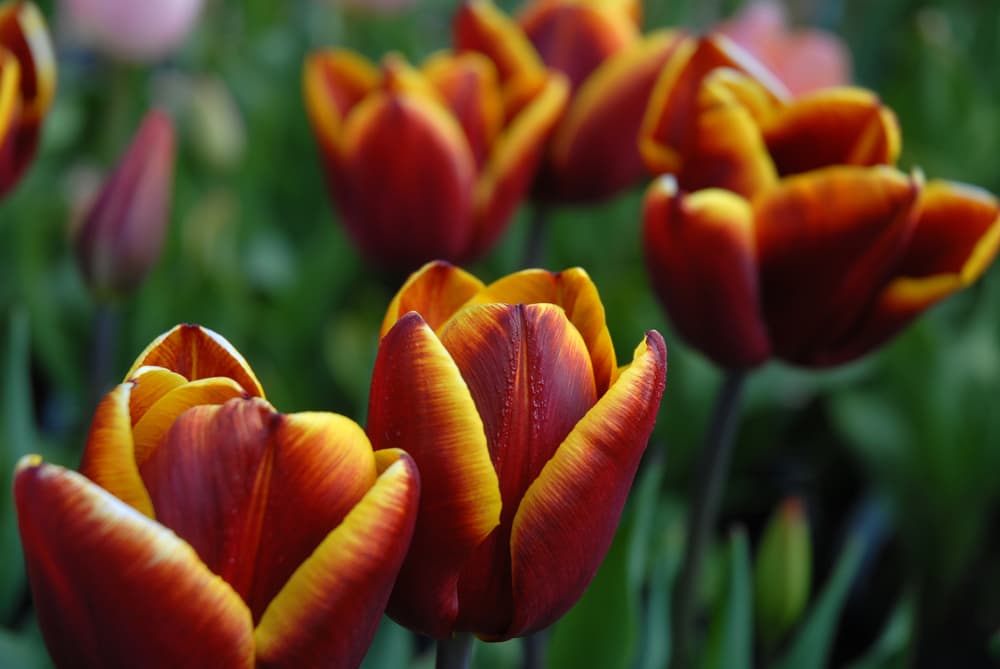
- PICTURED VARIETY: ‘Abu Hassan’
- ALSO RECOMMENDED: ‘Attila’
- SEASON OF INTEREST: MID
Division 3, ’Triumph’ are not too dissimilar from Single Early; they are a little more open, and cup-shaped as opposed to goblet-shaped, and some varieties bear bi-coloured flowers.
Division 4: Darwin Hybrid

- PICTURED VARIETY: ‘PINK IMPRESSION’
- ALSO RECOMMENDED: ‘APELDOORN’,DAYDREAM’, ‘HAKUUN’
- SEASON OF INTEREST: MID
Division 4, ‘Darwin Hybrid’ is a collection of hybrids of Single Earlies, Tulipa fosteriana and species Tulips.
As such, their shape and form includes varieties very similar to Tulipa fosteriana.
They are reliable perennials.
Division 5: Single Late

- PICTURED VARIETY: ‘CATHERINA’
- ALSO RECOMMENDED: ‘QUEEN OF NIGHT’, ‘VIOLET BEAUTY’
- SEASON OF INTEREST: LATE
Division 5, ‘Single Late’ are very similar to the Division 1 Singles except that the flowers are just a touch more open and they bloom at the end of spring.
Division 6: Lily-Flowered

- PICTURED VARIETY: ‘Ballade Dream’
- ALSO RECOMMENDED: ‘White Triumphator’ , ‘BALLERINA’
- SEASON OF INTEREST: LATE
Division 6, ‘Lily-Flowered’ tend to look like Tulips that are trying to be Lilies but with pointed tepal tips.
Both ‘White Triumphator’ and ‘Ballerina’ are reliably perennial and flower year after year.
Division 7: Fringed
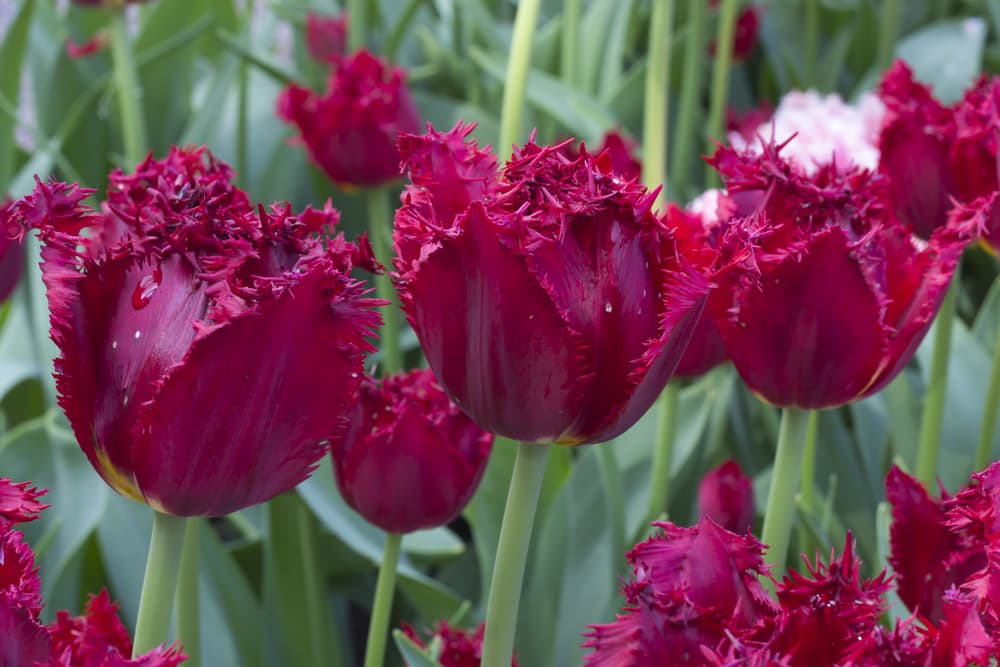
- PICTURED VARIETY: ‘TERRY RED’
- ALSO RECOMMENDED: ‘BLUE HERON’, ‘LAMBADA’
- SEASON OF INTEREST: LATE
Division 7, ‘Fringed’ literally have fringes, upright and spiky or wayward and dangling, on the edges of the petals.
Division 8: Virdiflora
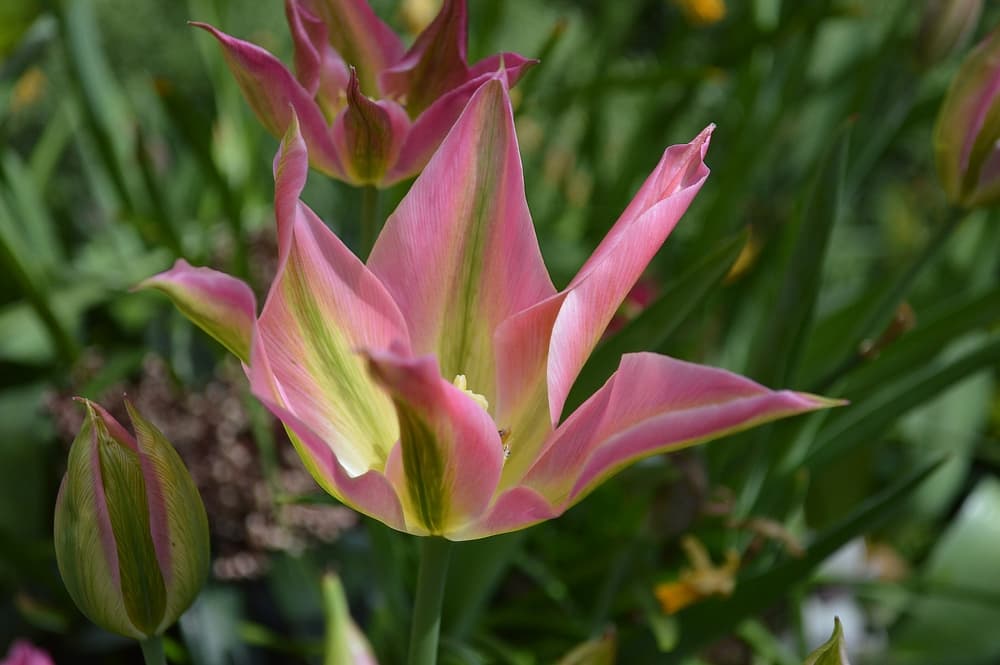
- PICTURED VARIETY: ‘GROENLAND’ (GREENLAND)
- ALSO RECOMMENDED: ‘CHINATOWN’, ‘DOLL’S MINUET’
- SEASON OF INTEREST: LATE
Division 8, ‘Virdiflora’ have flowers whose petals have flares, splashes, or blotches of green in varying shades.
Division 9: Rembrandt

- PICTURED VARIETY: ‘INSULINDE’
- ALSO RECOMMENDED: ‘INNER WHEEL’, ‘BRIDESMAID’
- SEASON OF INTEREST: LATE
Division 9, ‘Rembrandt’ have bi-coloured flowers that resemble those from the Tulip Mania days that were called ‘broken’ in Tulipish.
These display what seem for all the world to be paintbrush strokes.
Division 10: Parrot

- PICTURED VARIETY: ‘BLACK PARROT’
- ALSO RECOMMENDED: ‘WHITE REBEL’, ‘PINK VISION’
- SEASON OF INTEREST: MID
Division 10, ‘Parrot’, are distinguished by ruffled and curved petals with a feathery texture or appearance.
Division 11: Double Late
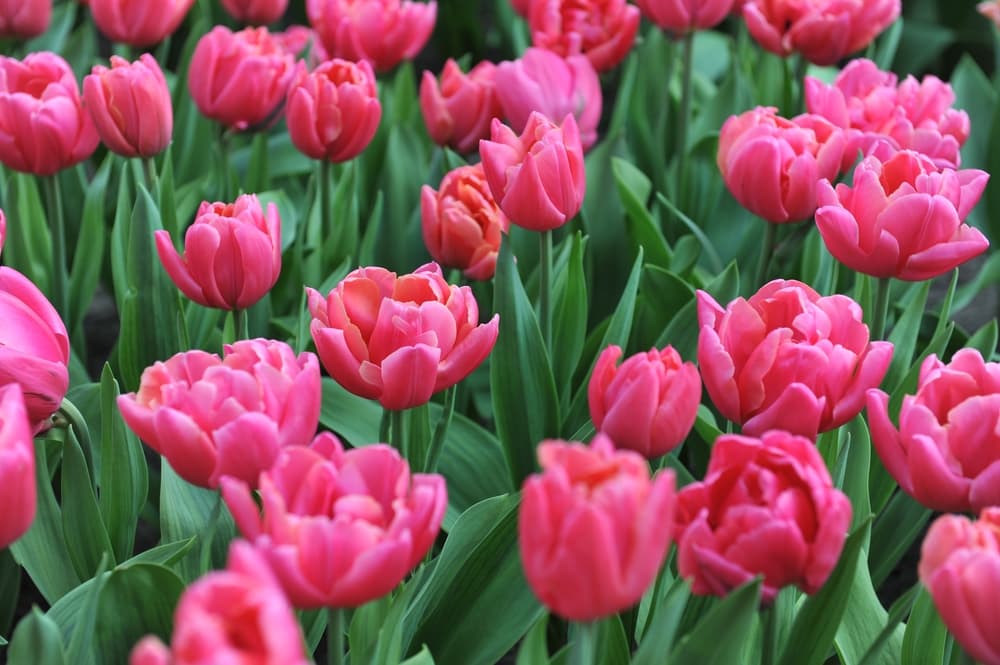
- PICTURED VARIETY: ‘SUNSET TROPICAL’
- ALSO RECOMMENDED: ‘SHIRLEY DOUBLE’, ‘YELLOW POMPONETTE’
- SEASON OF INTEREST: LATE
Division 11, ‘Double Late’, are surely misnamed because as Division 6 is called ‘Lily-Flowered’, these should be called ‘Peony-Flowered’ for parallel reasons; as well, many varieties bear scented blooms.
Division 12: Kaufmanniana
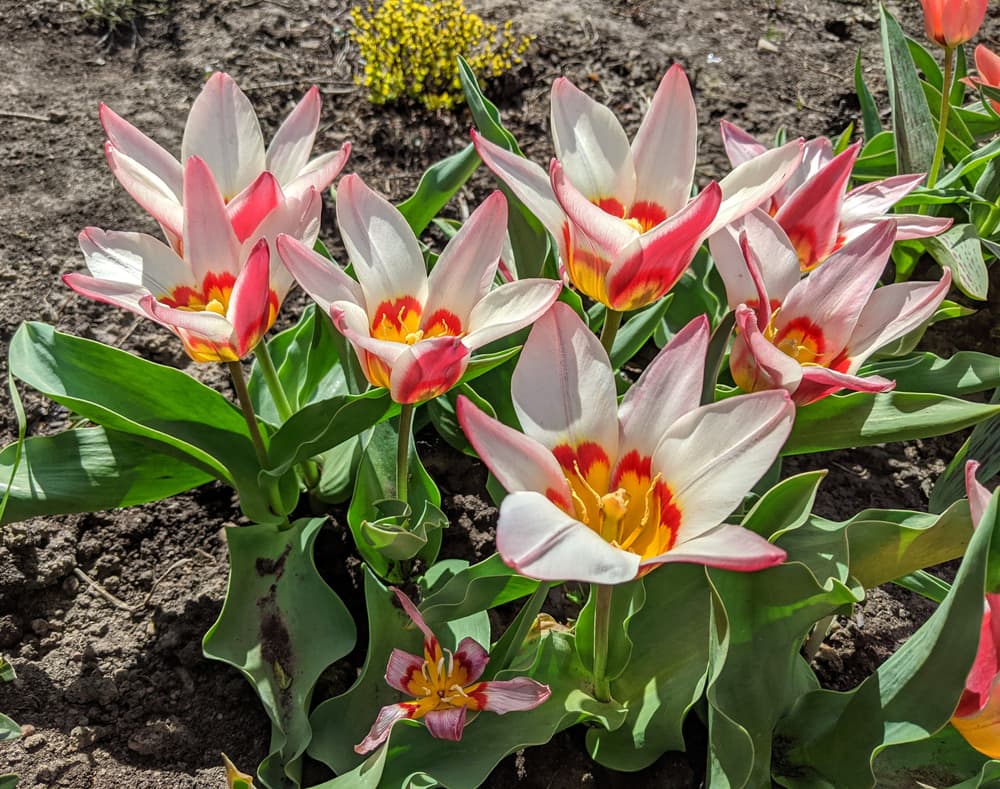
- PICTURED VARIETY: ‘ANCILLA’
- ALSO RECOMMENDED: ‘CAPE COD’, ‘JOHANN STRAUSS’
- SEASON OF INTEREST: EARLY
Division 12, ‘Kaufmanniana’, have elongated forms similar to ‘Single Early’ but with half-open pointed tepals that open nearly full and flat in sunlight.
Division 13: Fosteriana
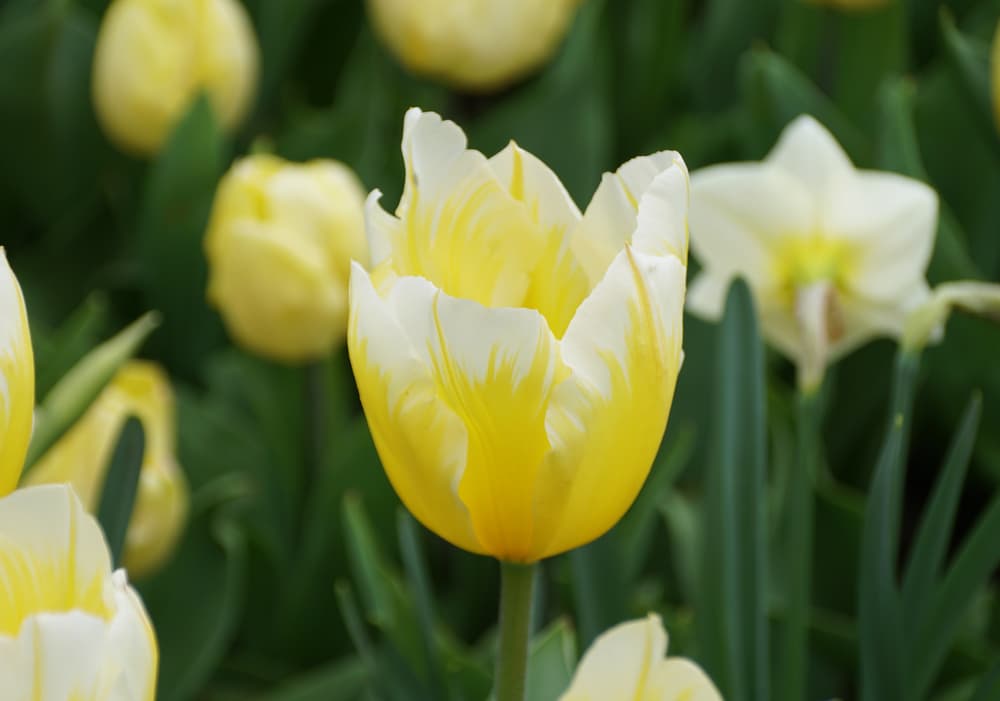
- PICTURED VARIETY: ‘SWEETHEART’
- ALSO RECOMMENDED: ‘PURISSIMA’, ‘ORANGE BRILLIANT’, ‘EXOTIC EMPEROR’
- SEASON OF INTEREST: EARLY
Division 13, ‘Fosteriana’ AKA ‘Emperor’, have the biggest blooms which, like the Double Earlys, are like ‘regular’ flowers and bear a passing resemblance to hollyhocks.
Division 14: Greigii

- PICTURED VARIETY: ‘RED RIDING HOOD’
- ALSO RECOMMENDED: ‘ALBION STAR’, ‘FUR ELISE’
- SEASON OF INTEREST: EARLY
Division 14, ‘Greigii’, are positioned as having ‘decorative foliage’ but in truth the real attraction is that it includes floral forms and features of, at least, Triumph, Rembrandt, and Kaufmanniana – in addition to which one stem bears up to four flowers.
Division 15: Species
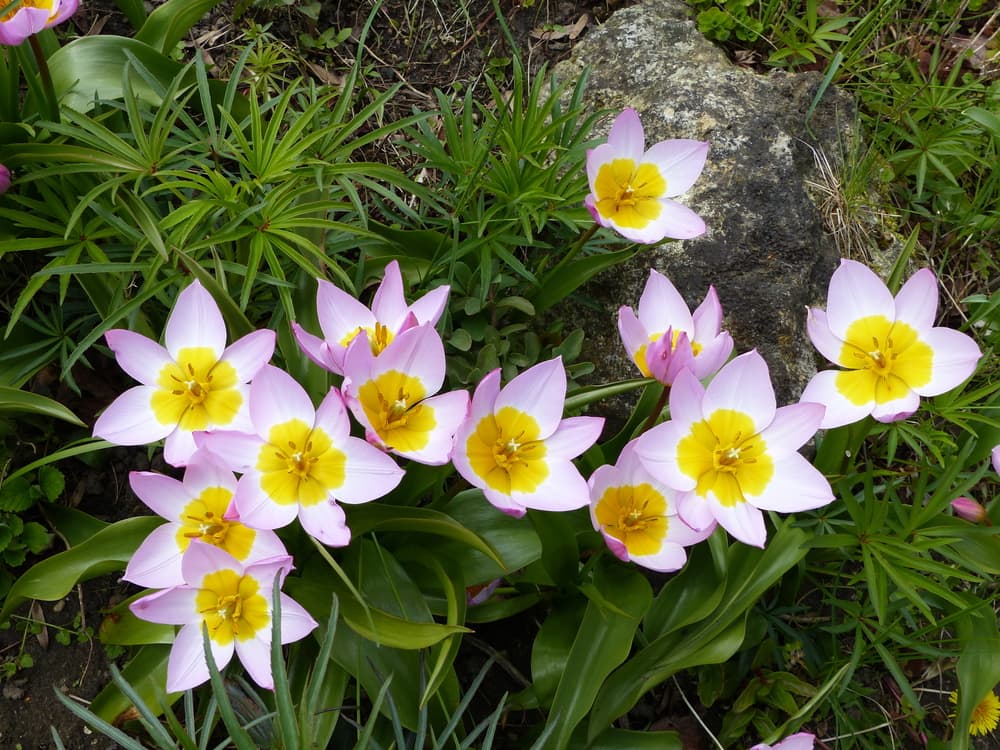
- PICTURED VARIETY: ‘Bakeri Lilac Wonder’
- ALSO RECOMMENDED: ‘Acuminata’, ‘Batalinii’
- SEASON OF INTEREST: EARLY
Division 15, ‘Species’ or ‘Botanical’, comprises the wild-growing progenitors of the hybrids and cultivars; in general, these have some of the smallest flowers borne on some of the shortest stems.
Division 16: Multiflowering
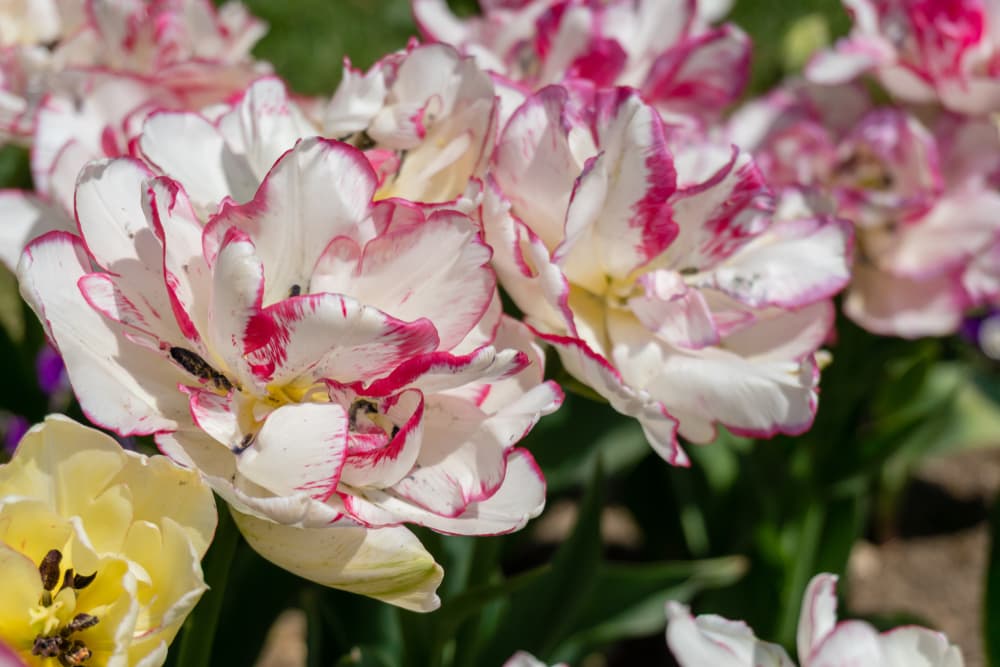
- PICTURED VARIETY: ‘BELICIA’ (div 2)
- ALSO RECOMMENDED: ‘AUCHERIANA’ (div 15), ‘FUSELIER’ (div 15)
- SEASON OF INTEREST: VARIES
Division 16, ‘Multiflowering’, includes plants in which a single branching stem bears four or five flowers with a few even bearing seven blooms.
“This isn’t an official division but is used to group multi flowering tulips otherwise listed within the 15 official divisions,” explains Master Horticulturist Roy Nicol.
The plants in these divisions are further differentiated by their heights and flowering season, and, to a lesser extent, the floral colours.
Indeed, Divisions 1, 2, 5, and 11 are identified by flowering season – early and late.
In contrast to each, Division 4, ‘Darwin Hybrid’ are mid-season bloomers, that is end-April, beginning-May.
References
- 1Tulipa. (n.d.). Pacific Bulb Society. Retrieved March 27, 2023, from https://www.pacificbulbsociety.org/pbswiki/index.php/Tulipa
- 2Tulip Species. (n.d.). Chicago Botanic Garden. Retrieved December 4, 2023, from https://www.chicagobotanic.org/plantinfo/tulips_species
- 3The Editors of Encyclopaedia Britannica. (1999c, May 4). Tulip | Description, Flower, Cultivation, & Facts. Encyclopedia Britannica. Retrieved March 27, 2023, from https://www.britannica.com/plant/tulip

